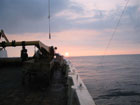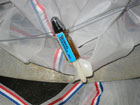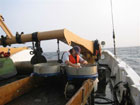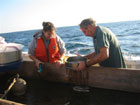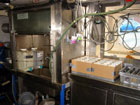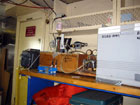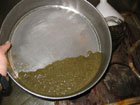

 | |||||||
|
|
Journals 2004/2005Aimee Gauthier
August 17, 2004 - Day 2 The buzz of the alarm clock came early, but I was excited to learn the solution to our first (and hopefully last) uncooperative bongo drop. There was a GORGEOUS sunrise at 6:05. It was amazing to see the sun come up over the horizon, without any buildings in its path. It is simply water as far as the eye can see. (Click on thumbnail below for full version pop-up) John determined after doing the vertical tow that there was actually a faulty CTD, so we made note of it and he changed it out for one that worked properly. John said he had to turn the boat around last night and do the station again. So he only slept for an hour or so. We have a very busy morning ahead of us. The second bongo tow went fine. I accidentally read the flow meters on the next backwards, but John was great about it. He said, do me a favor and check those meters again. Our tow was fine after that. John did the computer work and I washed the nets down with sea water. (Click on thumbnails below for full version pop-up) When washing down the nets, scientists want all the samples collected in the bottom of the net. The bottom of the net is tied up in a certain way with a shoe lace. We take the nets and wash the plankton into the bottom and then we collect it into a sieve. We need to tip the sieve so that the specimen is in one area and it is easy to remove. Then I bring the specimen into the wet lab and preserve it. (Click on thumbnail below for full version pop-up) How do I preserve the samples? The samples from both nets are color coded. I need to make sure that the colors of the nets correspond to the color of the jar that they go into. First I take the green labeled jar and spoon out the sample, which is about half of a liter. Then I need to make sure that the complete sample is put into the jar by rinsing out the sieve with sea water. Then I fill up the remainder of the jar with sea water and a jigger or 5 ounces of Formalin. Formalin the preservative that we used to prevent decay of the specimen, as they make their year long journey to and from the Poland lab. I repeat the same technique for the red labeled bongo. Finally I tightly tie the shoe laces around the bottom of the net, label the jars for next station and we are ready to proceed. (Click on thumbnails below for full version pop-up) After preserving the specimen, John showed me how to filter water. We manually checked the fluorometer. We put sea water into a filter and it traps the phytoplankton. We filtered out approximately 1000 ml of sea water. The filter paper is removed and stored for later use. (Click on thumbnails below for full version pop-up) On our next tow we will be doing a ZOOGEN sample. These samples will be sent to yet another lab where they will be analyzed to show relatedness of all the zooplankton in the area. They analyze and sequence the DNA to see comparisons. The smaller bongo nets are attached to the boom just above the larger bongo nets. The routine for the smaller nets are the same except there are no flow meters and they are preserved in ethanol. The formalin will degrades the DNA and then the samples cannot be analyzed. Yet another group of data is being collected on this ecosystem monitoring cruise or ECOMON cruise and it is the collection of phytoplankton. The phytoplankton is filtered out of the water. This sample is taken every five stations or so. The specimen is frozen and after analyzed for trace amount of a nitrogen isotope. In total we did about three stations from 6-12pm. We gathered eight one-liter jars of plankton. The plankton is mostly zooplankton, and I say this because it is not green. August 17, 2004 - Day 2 This watch is a little bit slower. There is probably only one station for the entire six hour watch. We came on a little early (5:45) and took the station from Karen and John Hawkins, because they already did a few. This tow was both the small and large bongo nets. Again, John showed me how to preserve the Zoogen samples. I watched him do the first sieve and then I did the second sieve. Then I preserved the samples from the large Bongo nets. These were gelatinous, which means it looks like brown Jell-O. It is a combination of jellyfish and fish larvae. This can be a problem for it clogs up the nets. But for right now it did not affect the tow. (Click on thumbnails below for full version pop-up) We now have over four hours between stations. It is estimated that I will not even do the next station because it is at the very end of the watch, more than likely John H and Karen will take control. I watched the sunset, which was even more beautiful if that is possible than sun rise. The pinks in the sun were inexplicable. As the sun set I looked over the port side of the ship and I spotted some dolphins playing. They were jumping right out of the water, but unfortunately by the time I got my camera, they were gone. Tony, a winch operator, showed me off the other side of the ship about 1000 meters away, a whole row of dolphins playing. There must have been one hundred of them leaping out of the water. I again attempted to photograph them, but they were not camera shy, but just too far away. (Click on thumbnails below for full version pop-up) One really can't beat this experience - It has been sunny and about 75 degrees. I have seen beautiful sunrises, sunsets, dolphins jumping through the air and I sometimes have to do a little bit of work. Not too shabby! The last station of the evening was at about 11:30 pm. I have not done anything in a few hours just lots of reading and emailing, but perhaps I should've had another cup of coffee because I was really tired, I could have made a major error. I almost h cost NOAA and NMFS $15,000 because the CTD almost hit the ocean floor. It came approximately 1 meter from the bottom and it should have been 5 meters away. I guess the sample was okay because we did not need to go back and do it again and the CTD was still taking data. I was lucky that the instruments were still functional. The sample had a little sand in it, and several jelly fish. They were the biggest ones I have seen this trip. They were about 2.5 inches in diameter. Return to Journals Index |
||||||
